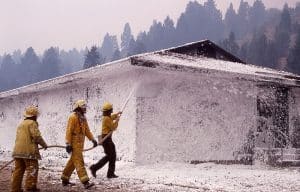 Contributed by Keith Pyron, Principal and Senior Geologist, PPM Consultants
Contributed by Keith Pyron, Principal and Senior Geologist, PPM Consultants
Many people like to save the best things for last. Fireworks shows end with the most spectacular bangs. Dinners end with dessert. Concerts end with the most popular songs. Saving the best for last leaves us with lasting feelings of happiness and accomplishment. But sometimes the things that linger with us at the end are not left by choice because they are wonderful, but because they prove to be challenging. Such is the case with per- and polyfluoroalkyl substances, known by the acronym, PFAS.
Beginning in the 1970s with the formation of the EPA, our nation began to address pollutants that were determined to be a priority for protecting our human health and the environment. Since that time, different harmful chemicals have been addressed, which have made their way into our air, soil, and groundwater. Some of these have been contaminants such as petroleum from underground storage tanks, or different priority pollutants released from chemical manufacturing plants. One by one, the issue of these chemicals being released to the environment has been tackled by the EPA. The environmental industry’s successes have been numerous, but before we cue the fireworks and fanfare, we have to direct our attention to PFAS. PFAS are a class of pollutants that may be harder to address than any major pollutants to date due to their prolific use, ubiquitous presence, serious health effects, and high cleanup costs.
PFAS are used in everything and are “forever chemicals”
Although PFAS have been in use since the 1940s, it was not until 1998 that EPA identified their harmful health hazards. During that time, PFAS were developed into more than 9,000 different chemical compounds used in many products found everywhere, including Teflon®, firefighting foam, shampoo, cosmetics, carpet treatments, food packaging, cleaning products and even dental floss. PFAS can be particularly bad at military bases and fire stations where it was used in foam form for firefighting training. It is also concentrated in chemical plants where Teflon® was manufactured. The 2018 movie entitled “Dark Waters” captured the perils that this contaminant can unleash upon a local community if it is released to the environment.

In addition to being used in a wide variety of everyday products, PFASs have been dubbed “forever chemicals” because they hang around forever and just do not break down in the environment. They are so widespread they now appear to be virtually everywhere, including rainwater. According to a study by Stockholm University, scientists found PFAS-tainted rainwater unsafe for human consumption all over the world. Even worse, if PFAS get into your body, there is currently no known way of getting them out. Most people have already been found to have PFAS in their blood.
PFAS have serious health effects
The Agency for Toxic Substances and Disease Registry (ATSDR) is a federal public health agency of the U.S. Department of Health and Human Services, based in Atlanta, Georgia. According to the ATSDR, PFAS have caused low birth weight, birth defects, delayed development, and newborn deaths in lab animals. However, the ATSDR goes on to say that humans and animals react differently to PFAS, and not all effects observed in animals may occur in humans. Scientists have ways to estimate how the exposure and effects in animals compare to what they would be in humans. PFAS are known to cause a host of problems inside your body like liver problems, thyroid problems, cancers, infertility, and immune system function. Who knew that something like Teflon® could have such a harmful effect on us?
Research on PFAS is so new that no one at this point can tell you even what levels are toxic to your body and at what level do they need to be cleaned up to in the soil and groundwater. One thing we do know is that it takes much less concentrations in your body and the environment to cause harm. With other chemicals like petroleum hydrocarbons and chlorinated solvents, we were content to measure harmful concentrations at the parts per million (ppm) or the parts per billion (ppb) level. With PFAS, its potential for toxicity has caused us to be concerned down to the part per trillion (ppt) level. Most states have not gotten around to establishing the maximum contaminant level, but to give you an idea of how tough the level can be, Florida currently as a proposal to adopt 70 ppt as the cleanup level for groundwater. Comparatively, benzyne (a petroleum contaminant) has a 1 ppb cleanup level for groundwater, which is three orders of magnitude less than PFAS.
PFAS have high cleanup costs
If all of this was not bad enough, costs for cleanup may run higher than any other contaminant to date. In fact, even trillions of dollars would not be enough to remove all of the PFAS from the environment. Since PFAS do not breakdown in the environment, more expensive remediation methods like removal or destruction in place has typically been used. The most common option currently used is to pump the impacted groundwater and send it through filtration systems that use granular active carbon and other filter media. Also to date, “methods to remediate PFAS have involved extreme heat, sorbents, and bioremediation (the use of microorganisms to break down contaminants), all of which can be costly and inefficient, and create secondary pollutants[1].” There is a certain fungus that is beginning to be used known as “white rot fungus” that is showing some promise. However, our industry is likely a long way away from having reliable and proven cost-effective methods of treatment.

The PFAS group of chemicals may be the most widespread contaminant and hardest to clean up of any so far. Maybe the environmental industry did save the worst for last. On the other hand, if we have learned anything in the environmental field that we work in, technology always marches on and does not stop until we find the technologies that work and are cost effective. It’s just a matter of time. Please don’t hesitate to reach out to me at (251) 709-6608 (or keith.pyron@ppmco.com) if you have questions about PFAS related issues or projects.

